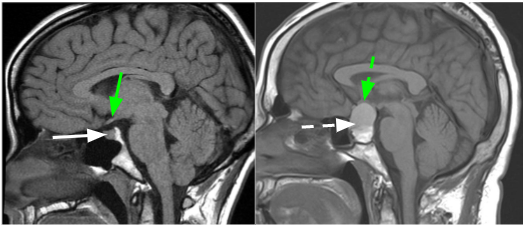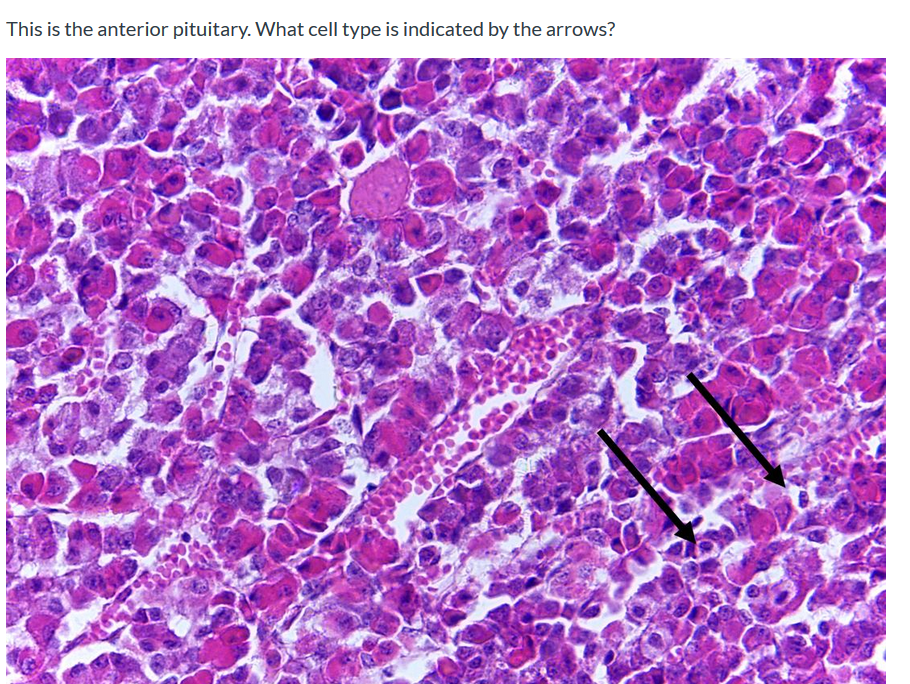A 30-year-old female patient presents with fatigue, weakness, weight loss, infertility, menstrual irregularities, and cold intolerance, as well as headaches. She begins to report peripheral vision loss. What is the name of this visual disturbance?

To remove a pituitary adenoma, surgeons most frequently approach the gland directly through which sinus?
Sphenoid sinus
Which of the following drugs primarily exerts its therapeutic effect by acting as a synthetic glucocorticoid receptor agonist?
A) Cortisone acetate
B) L-thyroxine
C) Conjugated estrogen
D) A combination of cortisone acetate and L-thyroxine
E) None of the above
A) Cortisone acetate
A 58-year-old male presents to his primary care physician with advanced stage prostate cancer. He has undergone multiple rounds of chemotherapy and radiation therapy with limited success in controlling the disease progression. His oncologist has discussed with him the possibility of enrolling in a clinical trial for an experimental immunotherapy drug. Additionally, the patient has been informed about a new surgical procedure being offered at a specialized center in a neighboring state that claims to offer promising outcomes for cases like his. He seeks advice from his primary care physician regarding these options.
Which of the following responses by the physician is most appropriate?
A) "You should avoid experimental treatments and focus solely on traditional therapies to manage your condition."
B) "Immunotherapy trials can offer potential benefits, but it's important to understand the risks and uncertainties associated with them. Let's discuss the specifics of this trial and consult with your oncologist."
C) "Surgery is often the best option for advanced prostate cancer. I recommend you pursue the new procedure immediately to improve your chances of survival."
D) "I advise against pursuing any further treatments at this point. It's crucial to prioritize your comfort and quality of life over aggressive interventions."
E) "I understand your concerns, but it's best to leave these decisions to your oncologist and surgeon. They are more equipped to assess the risks and benefits of these treatments."
Option B
This is the most appropriate response as it recognizes the potential benefits of experimental therapies while emphasizing the importance of informed decision-making and collaboration with the oncologist. This approach respects the patient's autonomy while ensuring they are well-informed about their treatment options. Therefore, option B is the correct choice.
Which of the following best describes the pathophysiology of Cushing's disease?
A) Excessive production of cortisol by the adrenal gland
B) Overstimulation of the thyroid gland leading to elevated cortisol level
C) Hyposecretion of cortisol due to dysfunction in the adrenal cortex
D) Hypersecretion of adrenocorticotropic hormone (ACTH) by the pituitary gland
D) Hypersecretion of adrenocorticotropic hormone (ACTH) by the pituitary gland
In Cushing's disease, the pathophysiology involves the hypersecretion of adrenocorticotropic hormone (ACTH) by the pituitary gland. This excessive ACTH stimulates the adrenal glands to produce and release excessive cortisol, leading to the characteristic symptoms of Cushing's syndrome.
Patient has an elevated 24-hr urine free cortisol, elevated late night salivary cortisol, and inadequate suppression on 1 mg overnight dexamethasone test.
What is the appropriate next step in making a diagnosis?
Measure serum ACTH
Provide at least two indications for transsphenoidal hypophysectomy.
At least two of the following:
- Secretory adenomas (excluding prolactinomas)
- Prolactinomas (if medical management fails)
- Symptomatic nonsecretory adenomas
- Pituitary apoplexy with visual symptoms
- Cancerous tumors of the pituitary gland
Which of the following is a potential contraindication for the use of conjugated estrogen in the treatment of hypopituitarism?
A) Hypothyroidism
B) History of breast cancer
C) Diabetes mellitus
D) Chronic kidney disease
E) Essential hypertension
B) History of breast cancer
A 24-year-old female recently underwent transsphenoidal hypophysectomy for treatment of an ACTH-secreting pituitary adenoma. She is interested in pasereotide to prevent tumor recurrence. She also states she is trying to conceive. What would you tell her about the safety of pasereotide in pregnancy?
A) The drug is safe to use during pregnancy
B) The drug is known to cause neural tube defects
C) The drug induces spontaneous abortion
D) There is limited data on this subject and the answer is not yet known
D) There is limited data on this subject and the answer is not yet known
Note: In animal studies, findings indicating developmental delay and retardation of physiologic growth were observed.
Why is it important to taper a course of cortisone in the treatment of hypopituitarism?
A) To reduce the risk of adrenal gland suppression
B) To minimize the occurrence of allergic reactions
C) To enhance the effectiveness of other hormonal replacements
D) To accelerate the restoration of pituitary function
A) To reduce the risk of adrenal gland suppression
Tapering a course of cortisone in the treatment of hypopituitarism is important to reduce the risk of adrenal gland suppression. Abrupt discontinuation of cortisone can lead to adrenal insufficiency due to suppressed adrenal function. Gradually tapering the medication allows the adrenal glands to gradually resume their normal function.
In a patient with increased 24-hr urine free cortisol and suppressed serum ACTH, what imaging is needed to differentiate between the two most likely diagnoses?
CT of the adrenals
Many surgical procedures carry some risk for bleeding, infection, and reaction to anesthesia. Transsphenoidal hypophysectomy carries some unique risks. Which of the following is not one of them?
A) CSF rhinorrhea
B) Meningitis
C) Pyridoxine deficiency
D) Diabetes insipidus
E) Visual problems
Pyridoxine (B6) deficiency
L-thyroxine exerts its therapeutic effects via which of the following signaling pathways?
A) cAMP
b) cGMP
c) IP3
D) Intracellular receptor
E) Receptor tyrosine kinase
F) Nonreceptor tyrosine kinase
D) Intracellular receptor
Mrs. Morais asks you about the efficacy of pasireotide in shrinking pituitary tumors in patients with Cushing's disease. Her husband is statistician. Naturally, she asks you what percentage of patients achieved significant tumor shrinkage?
A) 21%
B) 31%
C) 41%
D) 51%
E) 61%
C) 41%
Which of the following is a potential consequence of missing a dose of cortisone medication?
A) Increased risk of allergic reaction
B) Rapid weight gain
C) Decreased blood pressure
D) Enhanced immune response
C) Decreased blood pressure
Missing a dose of cortisone medication can indeed lead to decreased blood pressure due to a sudden drop in cortisol levels. This can result in symptoms such as dizziness, fainting, and fatigue.
A patient has an increased 24-hr urine free cortisol, elevated ACTH, and decreased ACTH and cortisol on high-dose dexamethasone suppression testing. Which imaging modality can be used to confirm the most likely diagnosis?
MRI of the pituitary (to identify the adenoma)

Following transsphenoidal surgical resection of a pituitary adenoma, the following labs were obtained:
Serum cortisol Low
TSH Low
Free T4 Low
FSH Low
LH Low
Estradiol Low
Urine specific gravity Normal
What is the name of this surgical complication?
Hypopituitarism
For the treatment of hypopituitarism cases in which serum T4 and T3 are low, L-thyroxine (synthetic T4) prescribed rather than synthetic T3. Which of the following is NOT a reason why this is done?
A) T4 has a longer Half-Life
B) T3 is less potent than T4
C) T4 provides more steady hormone levels
D) Synthetic T4 has been the standard treatment for many years and is well-studied
B) T3 is less potent than T4
Which of the following statements best reflects a key aspect of patient education regarding experimental drugs?
A) Patients participating in clinical trials for experimental drugs have guaranteed access to the medication being tested.
B) Patient education about experimental drugs primarily focuses on promoting the benefits while downplaying potential risk
C) Informed consent is a crucial component of patient education for experimental drugs, ensuring individuals understand the study's purpose, procedures, and potential risk.
D) Patient education for experimental drugs excludes discussions about alternative treatment options to maintain focus on the trial. E) Experimental drugs are typically offered as a first-line treatment option before traditional therapies have been explored.
Option C: Informed consent
This answer reflects a key aspect of patient education regarding experimental drugs. Informed consent is indeed a crucial component, ensuring that patients understand the purpose, procedures, potential risks, and alternatives associated with participating in a clinical trial for an experimental drug. This empowers patients to make informed decisions about their participation in research studies.
Cushing's disease recurs in what percentage of patients between 3 months and 13 years?
A) 14%
B) 19%
C) 24%
D) 29%
B) 14%
Recall our PBL/IQ case of Mrs. Morais. Classify her pituitary adenoma.
A) Macroadenoma/secretory
B) Macroadenoma/nonsecretory
C) Microadenoma/secretory
D) Microadenoma/nonsecretory
A) Macroadeoma/secretory
List the 5 main steps involved in a transsphenoidal hypophysectomy.
1. Prepare patient (e.g., anesthesia, positioning)
2. Insert endoscope in one nostril and make incision in front wall of sphenoid sinus
3. Open the sella
4. Remove the tumor
5. Close the sella opening with a fat and bone graft
In our PBL/IQ case, cortisone acetate, L-thyroxine, and conjugated estrogen were prescribed to address insufficient production of hormones from which gland?
A) Pineal
B) Anterior pituitary
C) Posterior pituitary
D) Adrenal
E) Thyroid
B) Anterior pituitary
True or False: Anatomical charts displayed in physician's offices typically adhere to a universal standardization, ensuring consistency in medical education and communication among healthcare professionals.
False.
Explanation: While anatomical charts are commonly displayed in physician's offices, there isn't a strict universal standardization for these charts. Different publishers may create their own versions, and variations can exist in terms of anatomical detail, labeling, and artistic style. While there are widely accepted conventions, subtle differences can still occur. Additionally, advancements in medical imaging and digital technology have introduced new forms of anatomical representation beyond traditional charts.

Chromophobe